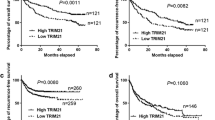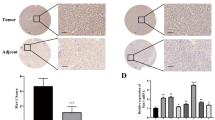Abstract
Tripartite motif–containing 29 (TRIM29), also known as the ataxia telangiectasia group D-complementing (ATDC) gene, has been reported to play an oncogenic or tumor suppressive role in developing different tumors. So far, its expression and biological functions in hepatocellular carcinoma (HCC) remain unclear. We investigated TRIM29 expression pattern in human HCC samples using quantitative RT-PCR and immunohistochemistry. Relationships between TRIM29 expression level, clinical prognostic indicators, overall survival (OS), and disease-free survival (DFS) were evaluated by Kaplan–Meier analysis and Cox proportional hazards model. A series of in vitro experiments and a xenograft tumor model were conducted to detect the functions of TRIM29 in HCC cells. RNA sequencing, western blotting, and immunochemical staining were performed to assess the molecular regulation of TRIM29 in HCC. We found that the mRNA and protein levels of TRIM29 were significantly reduced in HCC samples, compared with adjacent noncancerous tissues, and were negatively correlated with poor differentiation of HCC tissues. Survival analysis confirmed that lower TRIM29 expression significantly correlated with shorter OS and DFS of HCC patients. TRIM29 overexpression remarkably inhibited cell proliferation, migration, and EMT in HCC cells, whereas knockdown of TRIM29 reversed these effects. Moreover, deactivation of the PTEN/AKT/mTOR and JAK2/STAT3 pathways might be involved in the tumor suppressive role of TRIM29 in HCC. Our findings indicate that TRIM29 in HCC exerts its tumor suppressive effects through inhibition of the PTEN/AKT/mTOR and JAK2/STAT3 signaling pathways and may be used as a potential biomarker for survival in patients with HCC.







Similar content being viewed by others
Data availability
The data and materials used in this research are available from the corresponding author upon reasonable request.
References
Sung H, Ferlay J, Siegel RL, Laversanne M, Soerjomataram I, Jemal A, Bray F. Global cancer statistics 2020: GLOBOCAN estimates of incidence and mortality worldwide for 36 cancers in 185 countries. Cancer J Clin. 2021;71:209–49. https://doi.org/10.3322/caac.21660.
Zou H, Zhu CZ, Wang C, Wang ZS, Ma X, Han B, Wu LQ. Recurrence of barcelona clinic liver cancer stage A hepatocellular carcinoma after hepatectomy. Am J Med Sci. 2017;354:262–7. https://doi.org/10.1016/j.amjms.2017.05.014.
Watanabe M, Hatakeyama S. TRIM proteins and diseases. J Biochem. 2017;161:135–44. https://doi.org/10.1093/jb/mvw087.
Reymond A, Meroni G, Fantozzi A, Merla G, Cairo S, Luzi L, Riganelli D, Zanaria E, Messali S, Cainarca S, et al. The tripartite motif family identifies cell compartments. Embo J. 2001;20:2140–51. https://doi.org/10.1093/emboj/20.9.2140.
Sho T, Tsukiyama T, Sato T, Kondo T, Cheng J, Saku T, Asaka M, Hatakeyama S. TRIM29 negatively regulates p53 via inhibition of Tip60. Biochim Biophys Acta. 2011;1813:1245–53. https://doi.org/10.1016/j.bbamcr.2011.03.018.
Yanagi T, Watanabe M, Hata H, Kitamura S, Imafuku K, Yanagi H, Homma A, Wang L, Takahashi H, Shimizu H, et al. Loss of TRIM29 alters keratin distribution to promote cell invasion in squamous cell carcinoma. Cancer Res. 2018;78:6795–806. https://doi.org/10.1158/0008-5472.CAN-18-1495.
Yang Y, Li Q, Guo L. MicroRNA-122 acts as tumor suppressor by targeting TRIM29 and blocking the activity of PI3K/AKT signaling in nasopharyngeal carcinoma in vitro. Mol Med Rep. 2018;17:8244–52. https://doi.org/10.3892/mmr.2018.8894.
Li F, Liang J, Bai L. MicroRNA-449a functions as a tumor suppressor in pancreatic cancer by the epigenetic regulation of ATDC expression. Biomed Pharmacother. 2018;103:782–9. https://doi.org/10.1016/j.biopha.2018.04.101.
Wang C, Zhou Y, Chen B, Yuan W, Huang J. Prognostic value of tripartite motif containing 29 expression in patients with gastric cancer following surgical resection. Oncol Lett. 2018;15:5792–8. https://doi.org/10.3892/ol.2018.8059.
Liang C, Dong H, Miao C, Zhu J, Wang J, Li P, Li J, Wang Z. TRIM29 as a prognostic predictor for multiple human malignant neoplasms: a systematic review and meta-analysis. Oncotarget. 2018;9:12323–32. https://doi.org/10.18632/oncotarget.23617.
Li W, Xue H, Li Y, Li P, Ma F, Liu M, Kong S. ATDC promotes the growth and invasion of hepatocellular carcinoma cells by modulating GSK-3beta/Wnt/beta-catenin signalling. Clin Exp Pharmacol Physiol. 2019;46:845–53. https://doi.org/10.1111/1440-1681.13119.
Xu M, Hu J, Zhou B, Zhong Y, Lin N, Xu R. TRIM29 prevents hepatocellular carcinoma progression by inhibiting Wnt/beta-catenin signaling pathway. Acta Biochim Biophys Sin. 2019;51:68–77. https://doi.org/10.1093/abbs/gmy151.
Wang Y, Gao X, Ru X, Sun P, Wang J. A hybrid feature selection algorithm and its application in bioinformatics. Peerj Comput Sci. 2022;8:e933. https://doi.org/10.7717/peerj-cs.933.
Shi L, Xiao R, Wang M, Zhang M, Weng N, Zhao X, Zheng X, Wang H, Mai S. MicroRNA-342-3p suppresses proliferation and invasion of nasopharyngeal carcinoma cells by directly targeting Cdc42. Oncol Rep. 2018;40:2750–7. https://doi.org/10.3892/or.2018.6642.
Mai S, Xiao R, Shi L, Zhou X, Yang T, Zhang M, Weng N, Zhao X, Wang R, Liu J, et al. MicroRNA-18a promotes cancer progression through SMG1 suppression and mTOR pathway activation in nasopharyngeal carcinoma. Cell Death Dis. 2019;10:819. https://doi.org/10.1038/s41419-019-2060-9.
Liu J, Xu R, Mai SJ, Ma YS, Zhang MY, Cao PS, Weng NQ, Wang RQ, Cao D, Wei W, et al. LncRNA CSMD1-1 promotes the progression of hepatocellular carcinoma by activating MYC signaling. Theranostics. 2020;10:7527–44. https://doi.org/10.7150/thno.45989.
Qiao HY, Zhang Q, Wang JM, Jiang JY, Huyan LY, Yan J, Li C, Wang HQ. TRIM29 regulates the SETBP1/SET/PP2A axis via transcription factor VEZF1 to promote progression of ovarian cancer. Cancer Lett. 2022;529:85–99. https://doi.org/10.1016/j.canlet.2021.12.029.
Hao L, Zhang Q, Qiao HY, Zhao FY, Jiang JY, Huyan LY, Liu BQ, Yan J, Li C, Wang HQ. TRIM29 alters bioenergetics of pancreatic cancer cells via cooperation of miR-2355–3p and DDX3X recruitment to AK4 transcript. Mol Ther Nucl Acids. 2021;24:579–90. https://doi.org/10.1016/j.omtn.2021.01.027.
Liu Y, Mi Y, Mueller T, Kreibich S, Williams EG, Van Drogen A, Borel C, Frank M, Germain PL, Bludau I, et al. Multi-omic measurements of heterogeneity in HeLa cells across laboratories. Nat Biotechnol. 2019;37:314–22. https://doi.org/10.1038/s41587-019-0037-y.
Smits J, Dirks R, Qu J, Oortveld M, Brinkman AB, Zeeuwen P, Schalkwijk J, Zhou H, Marks H, van den Bogaard EH. Terminal keratinocyte differentiation in vitro is associated with a stable DNA methylome. Exp Dermatol. 2021;30:1023–32. https://doi.org/10.1111/exd.14153.
Ai L, Kim WJ, Alpay M, Tang M, Pardo CE, Hatakeyama S, May WS, Kladde MP, Heldermon CD, Siegel EM, et al. TRIM29 suppresses TWIST1 and invasive breast cancer behavior. Cancer Res. 2014;74:4875–87. https://doi.org/10.1158/0008-5472.CAN-13-3579.
Choi SK, Pandiyan K, Eun JW, Yang X, Hong SH, Nam SW, Jones PA, Liang G, You JS. Epigenetic landscape change analysis during human EMT sheds light on a key EMT mediator TRIM29. Oncotarget. 2017;8:98322–35. https://doi.org/10.18632/oncotarget.21681.
Sun J, Zhang T, Cheng M, Hong L, Zhang C, Xie M, Sun P, Fan R, Wang Z, Wang L, et al. TRIM29 facilitates the epithelial-to-mesenchymal transition and the progression of colorectal cancer via the activation of the Wnt/beta-catenin signaling pathway. J Exp Clin Cancer Res. 2019;38:104. https://doi.org/10.1186/s13046-019-1098-y.
Xu W, Chen B, Ke D, Chen X. TRIM29 mediates lung squamous cell carcinoma cell metastasis by regulating autophagic degradation of E-cadherin. Aging (Albany, NY). 2020;12:13488–501. https://doi.org/10.18632/aging.103451.
Xu R, Hu J, Zhang T, Jiang C, Wang HY. TRIM29 overexpression is associated with poor prognosis and promotes tumor progression by activating Wnt/beta-catenin pathway in cervical cancer. Oncotarget. 2016;7:28579–91. https://doi.org/10.18632/oncotarget.8686.
Zhou XM, Sun R, Luo DH, Sun J, Zhang MY, Wang MH, Yang Y, Wang HY, Mai SJ. Upregulated TRIM29 promotes proliferation and metastasis of nasopharyngeal carcinoma via PTEN/AKT/mTOR signal pathway. Oncotarget. 2016;7:13634–50. https://doi.org/10.18632/oncotarget.7215.
Karami FM, Ebrahimi M, Nourbakhsh E, Zia HA, Mirzaei A, Shafieyari S, Salehi A, Hoseinzadeh M, Payandeh Z, Barati G. PI3K/Akt/mTOR signaling pathway in cancer stem cells. Pathol Res Pract. 2022;237:154010. https://doi.org/10.1016/j.prp.2022.154010.
Huang B, Lang X, Li X. The role of IL-6/JAK2/STAT3 signaling pathway in cancers. Front Oncol. 2022;12:1023177. https://doi.org/10.3389/fonc.2022.1023177.
Xu J, Li Z, Su Q, Zhao J, Ma J. TRIM29 promotes progression of thyroid carcinoma via activating P13K/AKT signaling pathway. Oncol Rep. 2017;37:1555–64. https://doi.org/10.3892/or.2017.5364.
Yuan Z, Villagra A, Peng L, Coppola D, Glozak M, Sotomayor EM, Chen J, Lane WS, Seto E. The ATDC (TRIM29) protein binds p53 and antagonizes p53-mediated functions. Mol Cell Biol. 2010;30:3004–15. https://doi.org/10.1128/MCB.01023-09.
Acknowledgements
Not applicable.
Funding
This work was funded by the National Nature Science Foundation of China (Project No. 81772884 and 81772991).
Author information
Authors and Affiliations
Contributions
YTY performed the main experiments and wrote the manuscript. LS, CW, MYZ, JXL, YFZ and SCW assisted with all experiments. HYW and SJM designed the project. All authors have read and approved the final manuscript.
Corresponding authors
Ethics declarations
Conflict of interest
The author declares that they have no known competing financial interests or personal relationships that could have appeared to influence the work reported in this paper.
Ethical approval
All animal experiments were performed according to the Animal Ethics Procedures and approved by the Sun Yat-Sen University Animal Ethics Committee. The Institutional Review Board of Sun Yat-Sen University Cancer Center approved this study. Reference number: L102012017004C.
Consent for publication
Not applicable.
Additional information
Publisher's Note
Springer Nature remains neutral with regard to jurisdictional claims in published maps and institutional affiliations.
Supplementary Information
Below is the link to the electronic supplementary material.
Supplementary Fig. 1
TRIM29 overexpression inhibits EMT and mTOR signaling pathways in Bel-7402 cells.
Supplementary file1 (TIF 2146 KB)
Rights and permissions
Springer Nature or its licensor (e.g. a society or other partner) holds exclusive rights to this article under a publishing agreement with the author(s) or other rightsholder(s); author self-archiving of the accepted manuscript version of this article is solely governed by the terms of such publishing agreement and applicable law.
About this article
Cite this article
Yin, YT., Shi, L., Wu, C. et al. TRIM29 modulates proteins involved in PTEN/AKT/mTOR and JAK2/STAT3 signaling pathway and suppresses the progression of hepatocellular carcinoma. Med Oncol 41, 79 (2024). https://doi.org/10.1007/s12032-024-02307-7
Received:
Accepted:
Published:
DOI: https://doi.org/10.1007/s12032-024-02307-7




